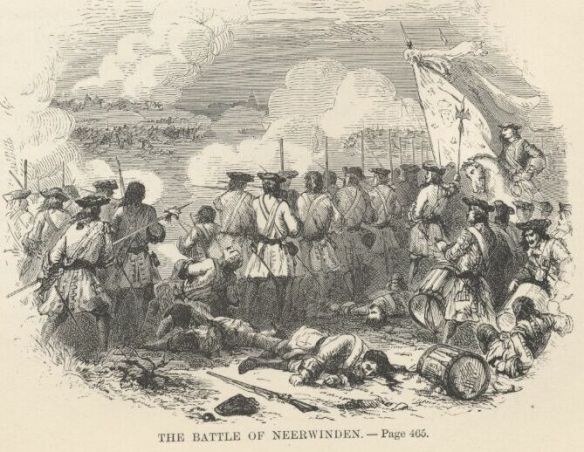“Landen.” A major battle of the Nine Years’ War (1688-1697), fought in Flanders. Maréchal Luxembourg brought 80,000 French to fight William III’s 50,000 Allied troops. Luxembourg lured William into battle with a series of feints with his cavalry, then surprised the Allied army in its camp. The fight began with both sides arrayed in battle line in an early morning mist made pungent by nearby marshy areas. The Allies were entrenched on high ground behind a shallow ravine at their center, with the flanks reaching two small villages. As he did at Fleurus (June 21/July 1, 1690), Luxembourg once again attacked both opposing flanks while French artillery pounded the enemy’s guns. After four hours of heavy fighting, Neerwinden village fell to a final assault by elite French and Swiss guards units. William withdrew, abandoning 84 of his 91 heavy guns along with 12,000 men left as casualties upon the field, with another 2,000 taken prisoner. The French also suffered heavy losses of about 8,000 men. Like most battles in Flanders in this era, even such high cost purchased little operational or strategic gain. An expensive and draining war of positions thus resumed.
duc de Luxembourg, François Henri de Montmorency, (1628-1695). Maréchal de France.
Like his cousin the Great Condé, Luxembourg fought in the Thirty Years’ War (1618-1648). He saw action at Lens (August 10, 1648), one of the last fights of that long and dirty conflict. Also like Condé, during the Fronde, Luxembourg turned against the monarchy and entered the service of Spain. He was captured at Rethel (October 15, 1650) but was soon released. He spent the next eight years fighting Louis XIV. He fought reluctantly at the Dunes (June 4/14, 1658). He returned to France and relative favor, along with his then more famous cousin, following promulgation of a royal amnesty that accompanied the Treaty of the Pyrenees (October 28/November 7, 1659).He led a French army that occupied Franche-Comté in 1668 during the War of Devolution (1667-1668). He fought again during the Dutch War (1672-1678), so well at the beginning in the campaign around Cologne, and so well and often thereafter, that in reward, the “Grande Monarque” raised him to the rank of “maréchal de France” in 1675. Luxembourg fought at Seneffe (August 11, 1674) alongside the Great Condé, and later commanded in the Rhineland as the successor to Turenne. He saw more action at Cassel (April 11, 1677). He opposed William III (then still Prince of Orange) at the needless battle of St. Denis (August 4/14, 1678).
Luxembourg fell from royal favor in 1679 over an odd court scandal concerning supposed use of black magic and performance of sacrilegious acts. He was confined for some months. He was back in favor at court within two years, following the intercession of Condé, and served as captain of the Gardes du Corps. One year into the Nine Years’War (1688-1697), he was restored to command of the main French army. He retained command in Flanders until his death in 1695, fighting and winning several minor and three major battles during those years. Most dramatically and daringly, he defeated Waldeck at Fleurus (June 21/July 1, 1690), after which he besieged and took Mons in March-April 1691. He commanded the French army of observation during the first siege of Namur (May 25-June 30, 1692). He beat William in the field at Steenkerke (July 24/ August 3, 1692) and again, and most bloodily, at Neerwinden (July 19/29, 1693).
Yet, Luxembourg’s field victories changed little in the larger context of the war. His main tactical and operational preoccupation remained maneuvers and positional warfare, which always dominated the Flanders theater of operations. The noted reluctance or inability of Luxembourg to pursue a beaten enemy after each of his battlefield victories is sometimes attributed to restraints placed on his freedom of action by Louis XIV. However, a greater commander would have made the case for hard pursuit and insisted upon carrying it out.
